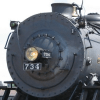Maine Maritime
Maine Maritime
Coming Soon!
Yes, coming to the RWA file library, it's the Maine Maritime route. Maybe you've heard of it somewhere before?
Maine Maritime is virtually identical to "that other" route, running from Pine Point to East Deering via downtown Portland, with a few minor improvements and upgrades along the way. However, unlike its predecessor there are no SD40s, since those are not ours to give away. Scenarios that originally featured them use GP40s as substitutes. Similarly, the GP40 cabs are now referenced to the generic "black" SD40. Also, we can't bundle the Kuju asset packs this time around, so you'll need to have both the US and European versions on hand in order for those assets to show up properly along with the many other custom assets.
A new locomotive has been added to our roster: the ALCo HH600, shown above in Portland Terminal livery. The HH600 was the first of a series of four-axle diesel-electric switchers built by ALCo beginning in 1931. The HH stands for "high hood" and 600 is the nominal engine horsepower. The HH600 was succeeded by the HH660, followed by the HH900, and the HH1000. A total of 177 units in the series were built, of which the Portland Terminal Company owned four. A few units still exist in revenue service, but most of the others are on display in railroad museums.
The HH600 was equipped with a 6-cylinder naturally aspirated engine, model 531 produced by McIntosh & Seymour, powering a General Electric GT551A1 main generator. The locomotive represented here is the earliest design, with slotted ventilation intakes beneath the access doors and a hard crease at the top of the nose. Later models had louvered doors for improved ventilation, and a fully rounded nose. The Blunt locomotive trucks, named after their inventor, were a unique and efficient design, but in the early 1940s the AAR Type A design became the standard for switchers.
The last locomotive in the HH series was built in 1940, after which ALCo introduced its "S" series of switchers.
You'll notice some similarities between this locomotive and the S-2 and RS-1 (which are also available in the file library). Indeed, ALCo reused many parts from one generation of locomotives to the next...and so did we!
Yes, coming to the RWA file library, it's the Maine Maritime route. Maybe you've heard of it somewhere before?
Maine Maritime is virtually identical to "that other" route, running from Pine Point to East Deering via downtown Portland, with a few minor improvements and upgrades along the way. However, unlike its predecessor there are no SD40s, since those are not ours to give away. Scenarios that originally featured them use GP40s as substitutes. Similarly, the GP40 cabs are now referenced to the generic "black" SD40. Also, we can't bundle the Kuju asset packs this time around, so you'll need to have both the US and European versions on hand in order for those assets to show up properly along with the many other custom assets.
A new locomotive has been added to our roster: the ALCo HH600, shown above in Portland Terminal livery. The HH600 was the first of a series of four-axle diesel-electric switchers built by ALCo beginning in 1931. The HH stands for "high hood" and 600 is the nominal engine horsepower. The HH600 was succeeded by the HH660, followed by the HH900, and the HH1000. A total of 177 units in the series were built, of which the Portland Terminal Company owned four. A few units still exist in revenue service, but most of the others are on display in railroad museums.
The HH600 was equipped with a 6-cylinder naturally aspirated engine, model 531 produced by McIntosh & Seymour, powering a General Electric GT551A1 main generator. The locomotive represented here is the earliest design, with slotted ventilation intakes beneath the access doors and a hard crease at the top of the nose. Later models had louvered doors for improved ventilation, and a fully rounded nose. The Blunt locomotive trucks, named after their inventor, were a unique and efficient design, but in the early 1940s the AAR Type A design became the standard for switchers.
The last locomotive in the HH series was built in 1940, after which ALCo introduced its "S" series of switchers.
You'll notice some similarities between this locomotive and the S-2 and RS-1 (which are also available in the file library). Indeed, ALCo reused many parts from one generation of locomotives to the next...and so did we!
You do not have the required permissions to view the files attached to this post.
- ricksan
- Forum Mod
- Posts: 311
- Joined: Fri Feb 13, 2009 10:55 am
- Location: Bandon, OR USA
Re: Maine Maritime
Good news! Thank you! "That other route" was the first add-on I bought for RW3.
-Tom Constantine
Acer Nitro N50-656, Core(TM) i5-14400F, 16 GB RAM, NVIDIA GeForce RTX 3050 /8GB, Win11 64bit up to date. Acer 23" monitor @ 1920x1080 x2
Acer Nitro N50-656, Core(TM) i5-14400F, 16 GB RAM, NVIDIA GeForce RTX 3050 /8GB, Win11 64bit up to date. Acer 23" monitor @ 1920x1080 x2
-

Overshoe - Posts: 574
- Joined: Mon May 26, 2014 4:49 pm
- Location: Bangor, Maine
Re: Maine Maritime
Fantastic work! I look forward to this project's progression. 


Anthony Nguyen
Youtube: https://www.youtube.com/fastfreightstudios
GeForce RTX 3050Ti Mobile, AMD Ryzen 7 5800H, 16GB RAM, 3TB Storage
It's January. So long...
-

ZekTheKid - Posts: 2430
- Joined: Mon Dec 29, 2014 6:05 pm
- Location: Cumberland, MD
Re: Maine Maritime
That other route is one of my all time favourites. You're spoiling us Rick and team! Thanks for all you do.
- DrewG
- Posts: 910
- Joined: Wed Jan 22, 2014 7:00 pm
- Location: Ontario, Canada
Re: Maine Maritime
For all of you late comers that couldn't get this route (the other route) to use the assets here it comes, Further this route it self is a great little gem to be enjoyed. We are honored to host this piece of our Country.
You do not have the required permissions to view the files attached to this post.
Buzz
39 and holding.
"Some people find fault like there's a reward for it."- Zig Ziglar
"If you can dream it you can do it."- Walt Disney

39 and holding.
"Some people find fault like there's a reward for it."- Zig Ziglar
"If you can dream it you can do it."- Walt Disney

-

buzz456 - Site Admin
- Posts: 21056
- Joined: Sun Mar 21, 2010 8:30 am
- Location: SW Florida
Re: Maine Maritime
It is now online. Thanks Rick and to all your helpers.
Bob Artim - Generation X²
I don't have a PHD, I have a DD214... Freedom carries sacrifice
I'm crawling in the dark looking for the answer
I don't have a PHD, I have a DD214... Freedom carries sacrifice
I'm crawling in the dark looking for the answer
-

artimrj - Posts: 4721
- Joined: Sun Jan 31, 2010 3:07 pm
- Location: Beaver, Pennsylvania
Re: Maine Maritime
I do not know if I got a bad download or ??? But one track south of Rigby yard is floating and of course bad connecting track as well.
Downloaded again and re installed. Same issue. Northbound track into Rigby starts floating just south of the yard.
Does anyone else have this issue?
Downloaded again and re installed. Same issue. Northbound track into Rigby starts floating just south of the yard.
Does anyone else have this issue?
Last edited by jamesphh on Wed Jan 30, 2019 6:25 pm, edited 2 times in total.
- jamesphh
- Posts: 388
- Joined: Fri Feb 13, 2009 2:28 pm
Re: Maine Maritime
Wow, this is spectacular. The Portland Terminal route has been one of my favorites, and that HH600 looks amazing. A big THANK YOU to all the developers!! 

**Not taking any requests**
Santa Fe All The Way
Nothing Runs Like a Deere
No Farms No Food
Ford Powerstroke
My 87 Ford: https://www.youtube.com/channel/UCvNRba ... _tNs53k42w
Santa Fe All The Way
Nothing Runs Like a Deere
No Farms No Food
Ford Powerstroke
My 87 Ford: https://www.youtube.com/channel/UCvNRba ... _tNs53k42w
-

ET44C4 - Posts: 3187
- Joined: Mon Aug 22, 2016 12:01 pm
- Location: Clover, South Carolina
Re: Maine Maritime
You do not have the required permissions to view the files attached to this post.
Buzz
39 and holding.
"Some people find fault like there's a reward for it."- Zig Ziglar
"If you can dream it you can do it."- Walt Disney

39 and holding.
"Some people find fault like there's a reward for it."- Zig Ziglar
"If you can dream it you can do it."- Walt Disney

-

buzz456 - Site Admin
- Posts: 21056
- Joined: Sun Mar 21, 2010 8:30 am
- Location: SW Florida
Re: Maine Maritime
Installing now, thanks to all of you for this!
- DrewG
- Posts: 910
- Joined: Wed Jan 22, 2014 7:00 pm
- Location: Ontario, Canada
Re: Maine Maritime
jamesphh wrote:I do not know if I got a bad download or ??? But one track south of Rigby yard is floating and of course bad connecting track as well.
Downloaded again and re installed. Same issue. Northbound track into Rigby starts floating just south of the yard.
Does anyone else have this issue?
Good Morning:
That is what happens to me also.
Chandler
Since it's the early worm that gets eaten by the bird, sleep late.
Since it's the early worm that gets eaten by the bird, sleep late.
- charliechan
- Posts: 227
- Joined: Sat Jun 27, 2009 7:21 pm
- Location: Smithfield, Ut.
Re: Maine Maritime
Picture? I was one of the beta guys and I am sure it wasn't there.
Buzz
39 and holding.
"Some people find fault like there's a reward for it."- Zig Ziglar
"If you can dream it you can do it."- Walt Disney

39 and holding.
"Some people find fault like there's a reward for it."- Zig Ziglar
"If you can dream it you can do it."- Walt Disney

-

buzz456 - Site Admin
- Posts: 21056
- Joined: Sun Mar 21, 2010 8:30 am
- Location: SW Florida
Re: Maine Maritime
I see the floating track too, and thanks to those who pointed it out. It's one of those TS quirks where the tracks are fine in one location, then you adjust something elsewhere and it displaces the track back in that first location. Sometimes you notice it...then there are those other times. 
Easy enough to fix. I'm the only one working on the route but I'll try to get a patch out in short order. Let's hope, after I fix this, something else doesn't get messed up! Will check the whole route this time.

Easy enough to fix. I'm the only one working on the route but I'll try to get a patch out in short order. Let's hope, after I fix this, something else doesn't get messed up! Will check the whole route this time.
- ricksan
- Forum Mod
- Posts: 311
- Joined: Fri Feb 13, 2009 10:55 am
- Location: Bandon, OR USA
Re: Maine Maritime
Just when I thought this route couldn't get better - it did...

You do not have the required permissions to view the files attached to this post.
**Not taking any requests**
Santa Fe All The Way
Nothing Runs Like a Deere
No Farms No Food
Ford Powerstroke
My 87 Ford: https://www.youtube.com/channel/UCvNRba ... _tNs53k42w
Santa Fe All The Way
Nothing Runs Like a Deere
No Farms No Food
Ford Powerstroke
My 87 Ford: https://www.youtube.com/channel/UCvNRba ... _tNs53k42w
-

ET44C4 - Posts: 3187
- Joined: Mon Aug 22, 2016 12:01 pm
- Location: Clover, South Carolina
Return to Freeware Add-On Releases
Who is online
Users browsing this forum: trendictionbot and 1 guest


